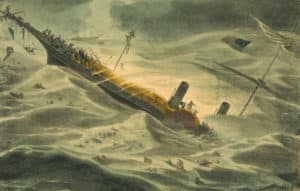
Damaged by a Category 2 hurricane, the SS Central America sank on Sept. 11, 1857, killing 425 passengers and crew members. Only about 150 people survived. Lost onboard was a huge amount of gold meant to help banks manage the financial panic that had started a month earlier. The wreckage and some of the gold were found in 1988. Image courtesy of the National Maritime Museum, London/Public Domain
What: Start of the Panic of 1857
When: August 24, 1857
Where: United States
When the Ohio Life Insurance and Trust Co.’s New York branch failed on Aug. 24, 1857 – reportedly due to bad investments and embezzlement – a financial panic began. Combined with other national and global economic events, the early days of the panic prompted banks to restrict loans.
To create a reserve for banks, the U.S. government arranged to ship gold to the East Coast from the San Francisco Mint. Transported to Panama and loaded onto the SS Central America in September, the gold was valued at about $2 million in 1857, equivalent to approximately $300 million today, according to the Library of Congress.
The SS Central America encountered a hurricane off the Carolinas on Sept. 9. The damaged ship sank two days later, exacerbating the panic. By October, more depositors withdrew money from banks, leading to a banking suspension in the Northeast on Oct. 14.
“The beginning of the contraction [of bank loans] on the twenty-fifth of August, marks the precise point at which the panic was started on its destructive course. From that date, distrust grew rapidly. The telegraph spread it throughout the country. Every latent cause of embarrassment sprung into activity. Trifling causes were a thousand-fold magnified. False alarms were created, and public apprehension kept up by successive disasters.”
—From “The Banks of New York, Their Dealers, the Clearing-House, and the Panic of 1857,” by J.S. Gibbons, 1858
To celebrate its 150th anniversary, Banker & Tradesman is highlighting significant moments in the history of Massachusetts’ real estate and banking industries. To suggest a topic, email editorial@thewarrengroup.com.





